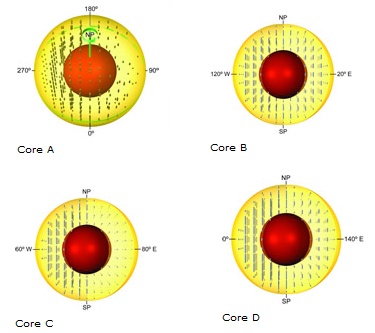Geologists at the University of Illinois have confirmed the discovery of Earth’s inner, innermost core, and have created a three-dimensional model that describes the seismic anisotropy and texturing of iron crystals within the inner core.
“For many years, we have been like blind men touching different parts of an elephant,” said U. of I. geologist Xiaodong Song. “Now, for the fist time, we have a sense of the entire elephant, and see what the inner core of Earth really looks like.”
Using both newly acquired data and legacy data collected around the world, Song and postdoctoral research associate Xinlei Sun painstakingly probed the shape of Earth’s core. The researchers report their findings in a paper accepted for publication in the journal Earth and Planetary Science Letters, and posted on its Web site.

Composed mainly of iron, Earth’s core consists of a solid inner core about 2,400 kilometers in diameter and a fluid outer core about 7,000 kilometers in diameter. The inner core plays an important role in the geodynamo that generates Earth’s magnetic field.
The solid inner core is elastically anisotropic; that is, seismic waves have different speeds along different directions. The anisotropy has been found to change with hemisphere and with radius. In the latest work, Sun and Song describe another anomaly – a global structure – found within the inner core.
“To constrain the shape of the inner core anisotropy, we needed a uniform distribution of seismic waves traveling in all directions through the core,” Sun said. “Since the seismic waves we studied were generated by earthquakes, one challenge was acquiring enough seismic waves recorded at enough stations.”
In their analysis, Sun and Song used a three-dimensional tomography technique to invert the anisotropy of the inner core. They parameterized the anisotropy of the inner core in both radial and longitudinal directions. The researchers then used a three-dimensional ray tracing method to trace and retrace the seismic waves through the inner core iteratively.
What they found was a distinct change in the inner core anisotropy, clearly marking the presence of an inner inner core with a diameter of about 1,180 kilometers, slightly less than half the diameter of the inner core.
The layering of the core is interpreted as different texturing, or crystalline phase, of iron in the inner core, the researchers say.
“Our results suggest the outer inner core is composed of iron crystals of a single phase with different degrees of preferred alignment along Earth’s spin axis,” Sun said. “The inner inner core may be composed of a different phase of crystalline iron or have a different pattern of alignment.”
Although the anisotropy of the inner core was proposed 20 years ago, “this is the first time we have been able to piece everything together to create a three-dimensional view,” Song said. “This view should help us better understand the character, mineral properties and evolution of Earth’s inner core.”
The work was funded by the National Science Foundation.





Comments